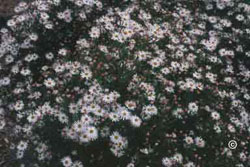Tough and reliable, asters are a natural for dry climates like ours where several native species delight mountain hikers. In fact, many aster varieties fail to survive the winter if kept too moist.
How big do cultivated asters grow?

Among cultivated asters, growth habits range from three-foot perennials to compact mounds. The greek word aster refers to the yellow-centered, star-like flowers that can be white, red, pink, purple, lavender and blue.
When do asters bloom?
Though asters generally bloom in late summer and fall, alpine aster blooms in May and June. This little rock-garden plant bears one-and-one-half inch, violet flowers, although white, blue, lavender, and pink flowers are also available. Alpine asters grow best in full sun and well-drained, moist soil.
 Wonder of Stafa hybrid aster is said to be one of the ten best perennials. The soft, lavender-blue flowers blend well with most other flower colors. After they start to flower in August, they bloom almost continually until late October.
Wonder of Stafa hybrid aster is said to be one of the ten best perennials. The soft, lavender-blue flowers blend well with most other flower colors. After they start to flower in August, they bloom almost continually until late October.
What asters do my local gardens carry?
Local garden centers and nurseries also stock varieties of New England aster, and many more of the New York aster, also called Michaelmas daisy. New York asters produce one-inch flowers that cover the full range
of aster colors. Heights range from a few inches to four feet.
Are asters easy to care for?

Asters are easy to cultivate, but powdery mildew can be a problem. To control the initial onset and spread of the disease, divide asters yearly in the spring. Replant the outer portions, and discard the spent center of the clump.
Combine asters with mauve Joe-Pye weed, northern goldenrod, white coneflower or the tawny seedheads of feather-reed grass for a complete fall show.
For “Powdery Mildew” refer to message number 1415.
For more information, see the following Colorado State University Extension fact sheet(s).



